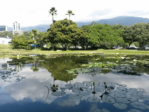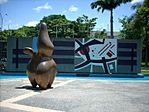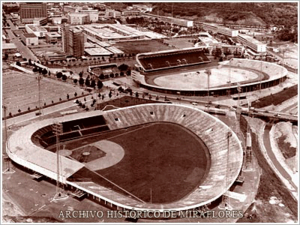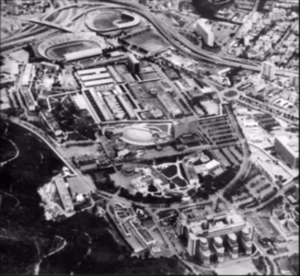University City of Caracas facts for kids
| UNESCO World Heritage Site | |
|---|---|
| Location | Libertador Bolivarian Municipality, Capital District, Caracas, Venezuela |
| Criteria | Cultural: (i), (iv) |
| Inscription | 2000 (24th Session) |
| Area | 164,203 ha (405,750 acres) |
The University City of Caracas (in Spanish: Ciudad Universitaria de Caracas), also called CUC, is the main campus of the Central University of Venezuela (UCV). It is located in central Caracas, the capital city of Venezuela. A famous Venezuelan architect named Carlos Raúl Villanueva designed it. In 2000, UNESCO named it a World Heritage Site.
Many people think the University City of Caracas is a "masterpiece" of architecture and city planning. It also had a big impact on how buildings were designed in Venezuela. Villanueva worked on the design after World War II. He also supervised building the campus for 20 years. It is the only university campus designed by just one architect in the 20th century. It has also received special cultural heritage recognition from UNESCO.
The campus has many different areas. Its northern part is a Botanical Garden. There are also large sports areas on its east, west, and south sides. Different parts of the campus are for different subjects, like Science, Architecture, and Medicine. These areas meet in the middle of the campus at the Tierra de nadie. This is a green space that doesn't belong to any one subject. The Plaza Cubierta complex also has shared buildings and a museum with modern art.
Even though some parts of the campus are getting old or damaged, it is still a very important place in Venezuela. Its design and planning are still excellent. It was even put on the World Monuments Fund list in 2010 and 2014. This means it needs special help to be preserved.
Contents
Building the Campus: Design and Planning
The campus and buildings of the UCV are seen as Villanueva's best work. It was built on the old Hacienda Ibarra. This land used to belong to Simon Bolívar's family. The project was huge, needing a lot of city planning and building design. Villanueva used this chance to combine art and architecture on a large scale. This big city complex is about 2 square kilometers. It has forty buildings. It became one of the most successful examples of Modern Architecture in Latin America. Villanueva worked closely with all the artists. He also personally watched over the project for more than 25 years.
After the death of Juan Vicente Gómez, Caracas started many new city projects. Villanueva's "Synthesis of Arts" architecture was part of this. The campus helped make Caracas famous and brought in visitors.
In 1939, groups started new city plans for Caracas. In 1942, the government bought the Hacienda Ibarra. This was to make the university bigger. The planning for the campus started again near the end of Second World War. Building began in 1944 and continued until 1967. The University City is an example of Villanueva's "museum-like" spaces. These spaces bring the qualities of museums to public places.
Villanueva visited France in 1944 and 1948. This gave him ideas for the campus's art and design. He changed his designs in 1949. The University City is also like a model city. It was meant to bring ideas of a perfect city to life.
The first buildings built were for medicine. In 1949, the first designs were changed. The stadiums were built in 1950 and opened in 1951. Building the stadiums started a new part of developing the Central Complex of the campus.
The campus construction started on its western side. This part has a balanced design. But when the Central Complex began, Villanueva did not use a balanced design. Instead, he started combining arts for this part of the campus.
Botanical Garden
The Caracas Botanical Garden is inside the campus. It has a large collection of plants from all over the world. It has had plants from Central and South America, Africa, and Asia. The garden once had 2,500 plants from over 200 species. Half of these were native to Venezuela. The Palmetum, a palm tree area, once had 4,000 palm trees of 250 species. The gardens opened in 1952 and cover 70 hectares. They also include the Henri Pittier Library.
Like other parts of the campus, the gardens have suffered from not being cared for enough. Not enough water and harmful plants have caused plants to die. The beauty of the gardens has also suffered. Problems like a drought in 2010 and thefts of equipment have hurt the gardens. In 2019, staff said no water had reached the garden's pipes for months. Volunteers then started bringing water to the plants by hand.
Lake Venezuela
Lake Venezuela is the biggest body of water on the campus. It is shaped like the country it is named after. By 2018, the lake had lost half its water. The native Santa Cruz water lilies, which were 8 feet wide, had died. Other lakes in the gardens are completely dry.
Plaza Cubierta and Tierra de nadie
The Central Complex of the University City has many buildings. These include academic, office, and social buildings. It also has some of the campus's most famous artworks.
The Plaza Cubierta is an indoor-outdoor space. It was designed as an "open museum." It mixes art into the environment and architecture into art. It is seen as one of the most important art and cultural works in Venezuela. It also connects many different buildings in the Central Complex. Villanueva wanted the Plaza Cubierta to be the heart of the campus. It was opened with the Aula Magna on March 2, 1954.
Buildings connected by the Plaza Cubierta include the main library and the rectory offices. It also connects the students' union, the Aula Magna, and the concert hall. The Aula Magna is considered the best example of combining arts. The Plaza Cubierta has walls with holes, open roof sections, and ramps. These features make it feel like it flows. In 2013, an open library project started in the Plaza Cubierta. This was to share books and enjoy the campus spaces.
The Rectory Plaza was meant to be a car park. It was built in 1952. But too many cars used it, so it closed to cars in 1958. The Rectory building has offices for university and student leaders. Where there was a post office is now a Bank of Venezuela. The Rectory Plaza has large murals and the UCV Clock Tower.
The Modernist art was even used in a 1956 American film called Assignment: Venezuela. The film tried to get oil workers to move to Maracaibo. In the film, a character named Jim visits the new campus. He admires the murals and statues. He arrives in what would become Rectory Plaza when it was still a car park.
Behind the Rectory Plaza buildings is the Paraninfo. This is a small space for performances. It has large stained-glass windows.
The Aula Magna is between the Plaza Cubierta and the main library. The inside of the hall is very important for art and architecture. Its most famous feature is Alexander Calder's 'clouds'. These clouds help with the sound in the hall. They also look beautiful. The concrete shell-shaped building outside is also important. It is called the "most important auditorium" at the university.
Beyond the Aula Magna are the Sala de Conciertos and the Central Library. The Sala de Conciertos entrance is in the covered hallways. It is marked by a large yellow mural. The library has a special red tile design on its outside. On an eastern wall, it has a large stained-glass window by Fernand Léger.
The Jorge Rodríguez Plaza separates the Plaza Cubierta from the academic buildings and sports areas. It is better known as the Tierra de nadie (meaning No-man's land). The Tierra de nadie is a public green space in the University City of Caracas. It is called "No-man's land" because it does not belong to any of the specific university departments around it.
Sports Facilities
The Olympic Stadium at the university is one of the special design parts highlighted by UNESCO. It is mainly a association football stadium. It is the home field of Caracas F.C.. It can hold almost 24,000 people. Besides the football field, the Olympic Stadium has a running track. It also has areas for athletic events like jumping. It also hosts rugby games.
The Covered Gymnasium is also a public space run by the university. It is at the far northern end of the campus, not counting the Botanical Garden. It is known for its unique shape and roof. It also has a giant mural. This mural marks the edge of the campus by the highway. It shows important historical figures of Venezuela.
The Estadio Universitario is a baseball stadium. It is next to the Olympic Stadium. It is the home field for two baseball teams. It can hold over 25,000 people.
Artworks
Many artworks on the campus were made somewhere else. They needed to be adjusted to fit the campus. Some of these works include Berger des nuages by Arp and L'Amphion by Laurens. Most other artworks were designed with artists and the architect talking a lot. But some murals were created right on the campus. These include works by Léger and Vasarely.
Artists from other countries who helped with the campus include: Hans Arp, Alexander Calder, Henri Laurens, Fernand Léger, and Victor Vasarely. Venezuelan artists involved include: Mateo Manaure, Francisco Narváez, Alejandro Otero, and Jesús-Rafael Soto.
- Selection of artworks in University City of Caracas
-
Berger des nuages by Jean (Hans) Arp, 1953
-
Floating Clouds by Alexander Calder, 1953
-
L'Amphion by Henri Laurens, 1953
-
Projection dynamique dans l'espace au 30° degré by Antoine Pevsner, 1953
-
Bimural by Fernand Léger, 1954
-
Sophia by Victor Vasarely, 1954
-
Mural de Francisco Narváez, UCV 001.JPG
Mural by Francisco Narváez, 1951
-
Composición Estática-Composición Dinámica by Oswaldo Vigas, 1954
-
Stained-glass window by Alejandro Otero, 1954
World Heritage Site Status
The campus was named a World Heritage Site in 2000. It was chosen because it is a masterpiece of architecture and city planning by Villanueva. It is also a great example of practical and beautiful architecture. It shows the ideas of early 20th Century art and architecture movements. UNESCO says it is "an outstanding example of the Modern Movement in architecture." They also say it brings together many buildings and uses into one clear design. This includes masterpieces like the Aula Magna with Alexander Calder's "Clouds," the Olympic Stadium, and the Covered Plaza.
UNESCO knows that the site's main design ideas are still there. But they are worried that the concrete structures are getting old. These structures are important to the campus's original design. They are also concerned that social problems could damage the site. Soil erosion is also a threat. A large increase in students could also cause more damage. Also, changes made to parts of the campus without thinking about the original design could harm its value. However, UNESCO adds that no changes have ruined the campus's true look or value.
There are groups that want to protect the site. But UNESCO says these groups do not work together well. They suggest that different government and university groups need to coordinate. It was also suggested that a special "buffer zone" be created. This would be to the south and west of the site. It would protect it from new city developments.
See also
 In Spanish: Ciudad Universitaria de Caracas para niños
In Spanish: Ciudad Universitaria de Caracas para niños





























